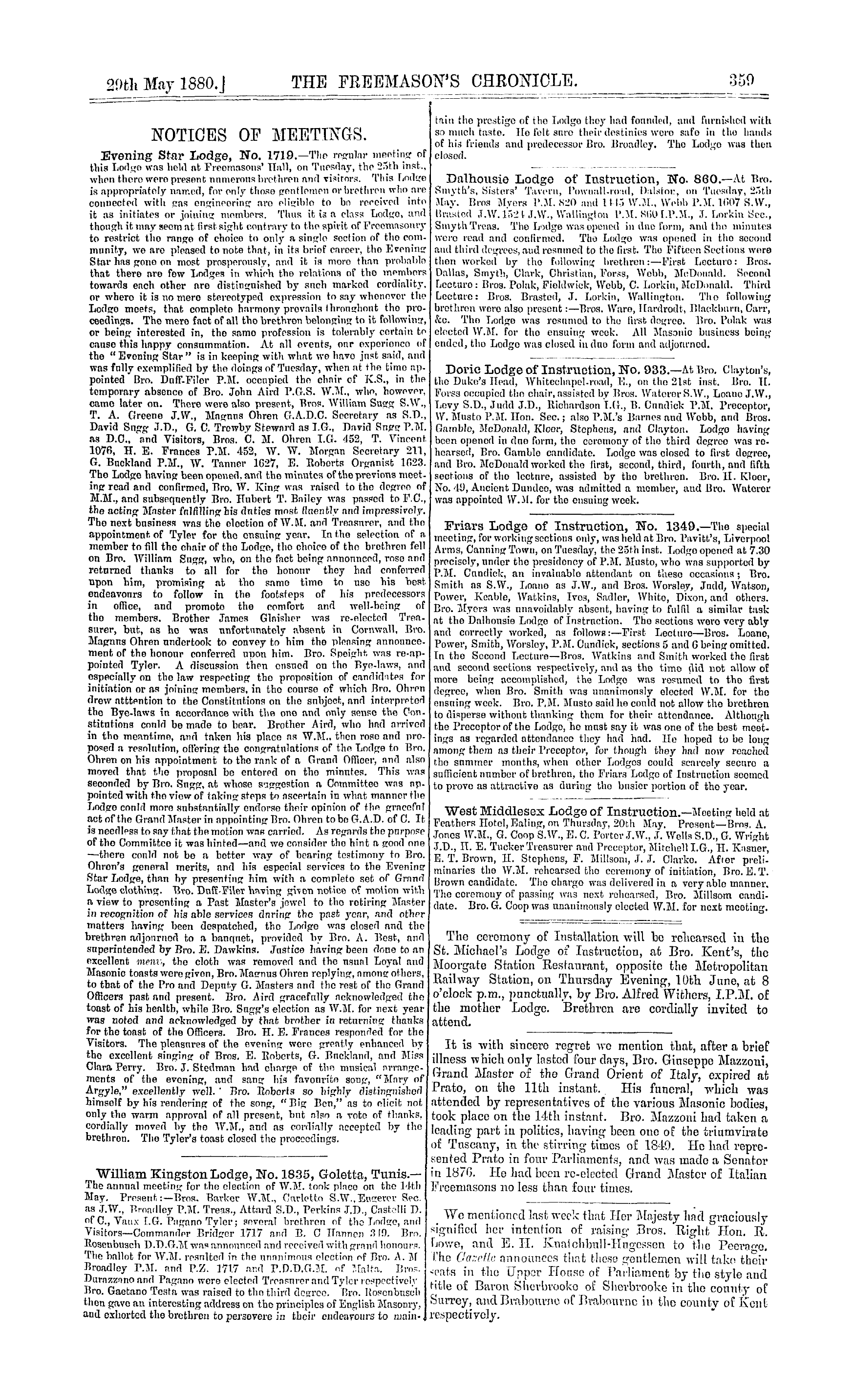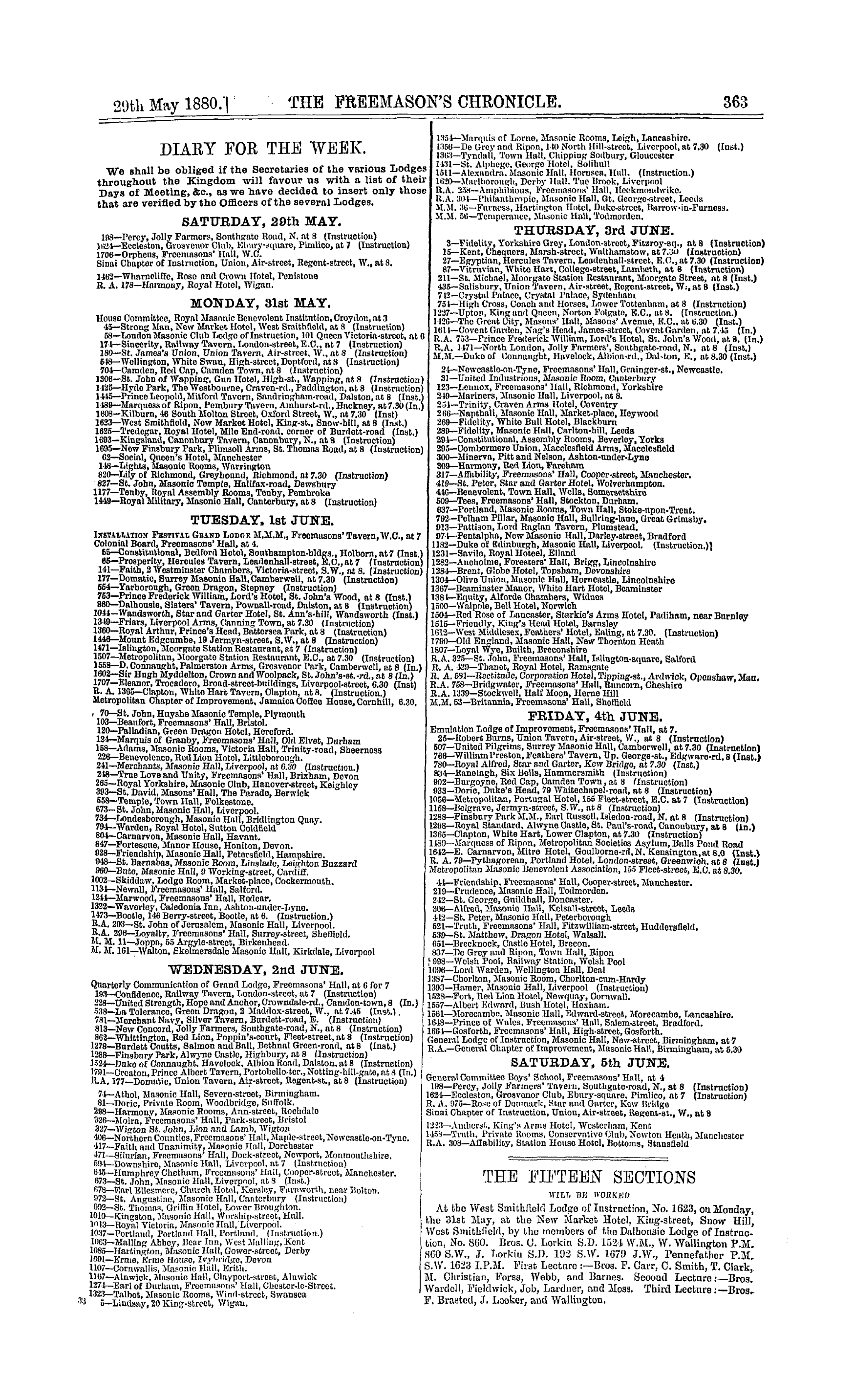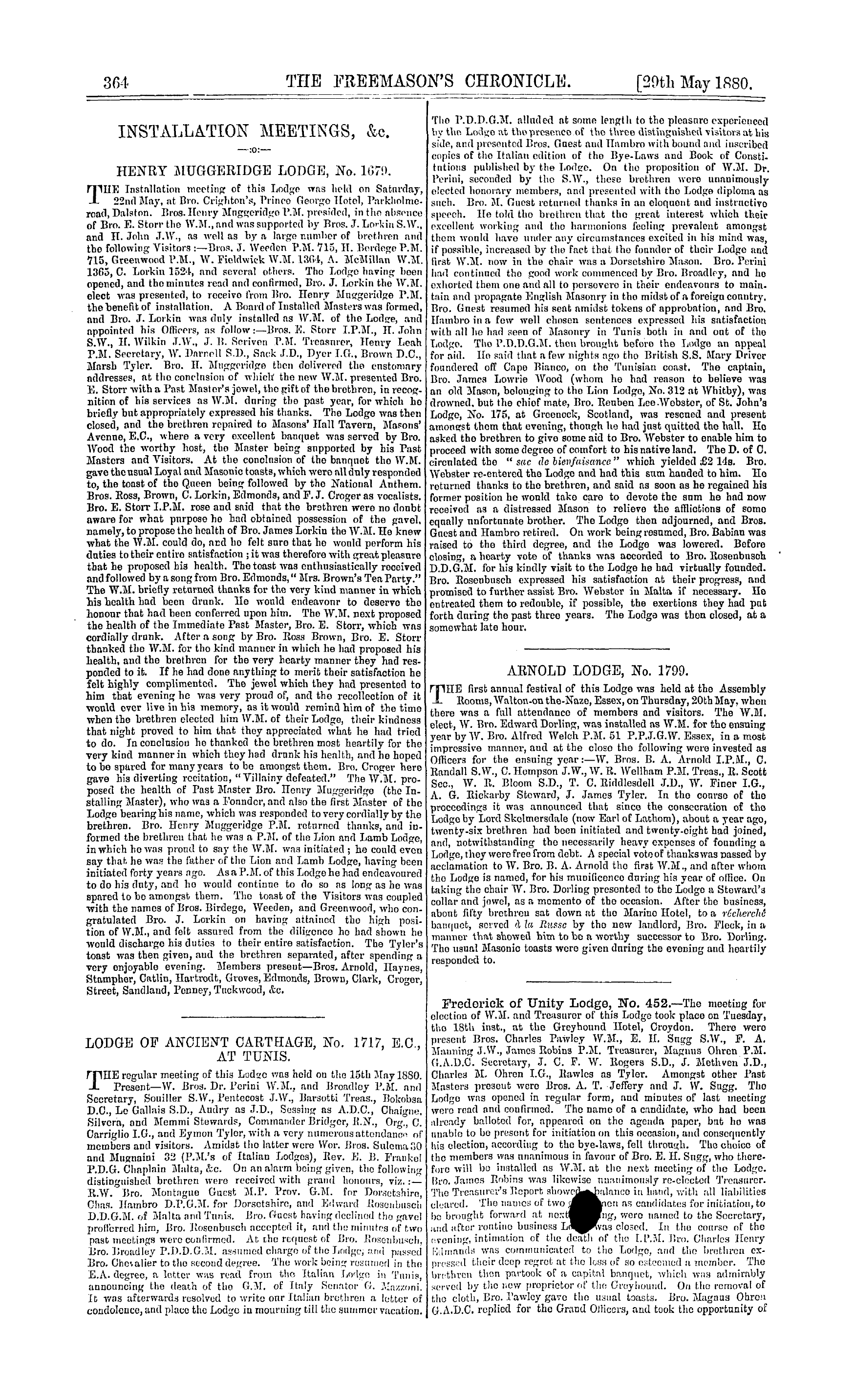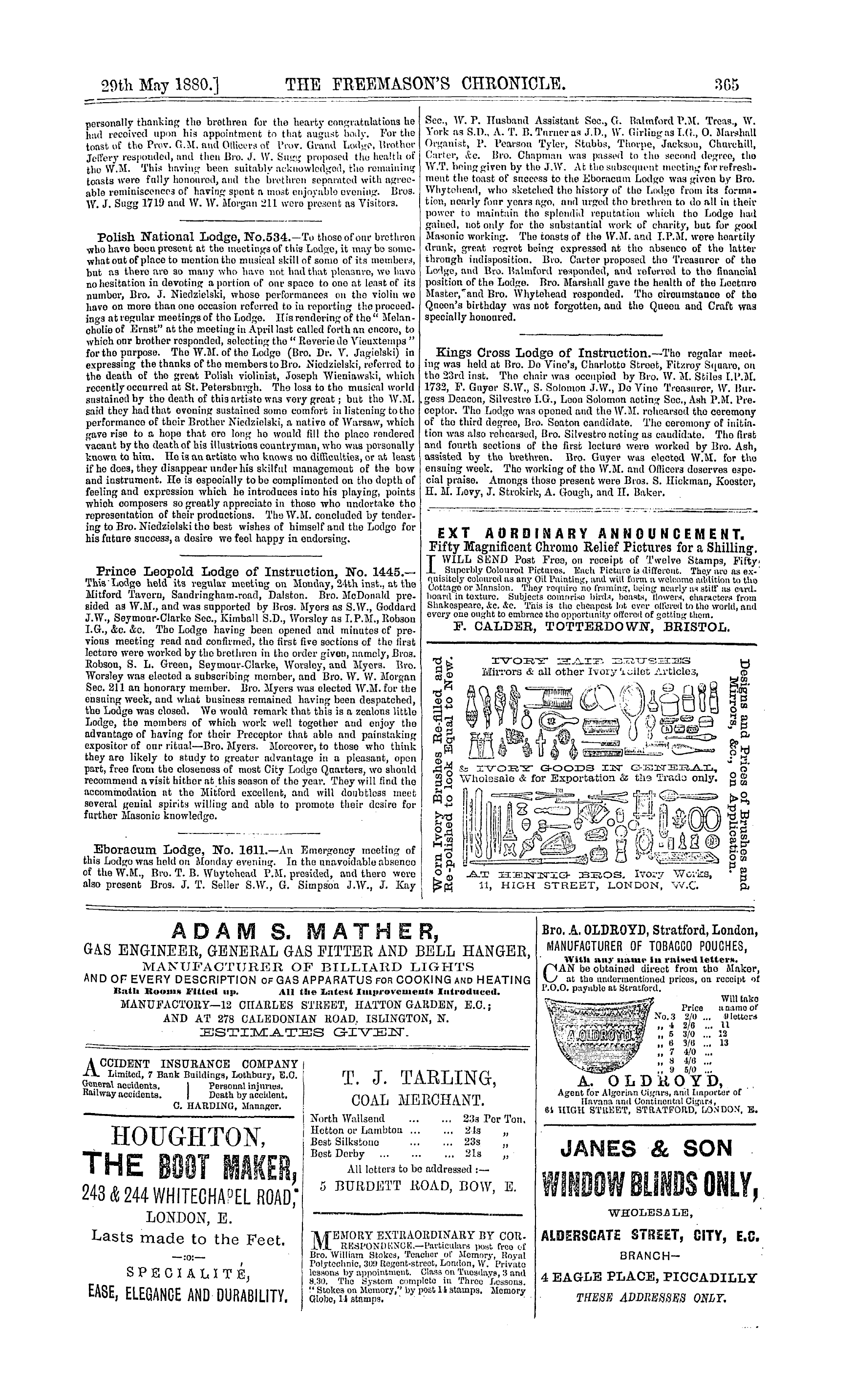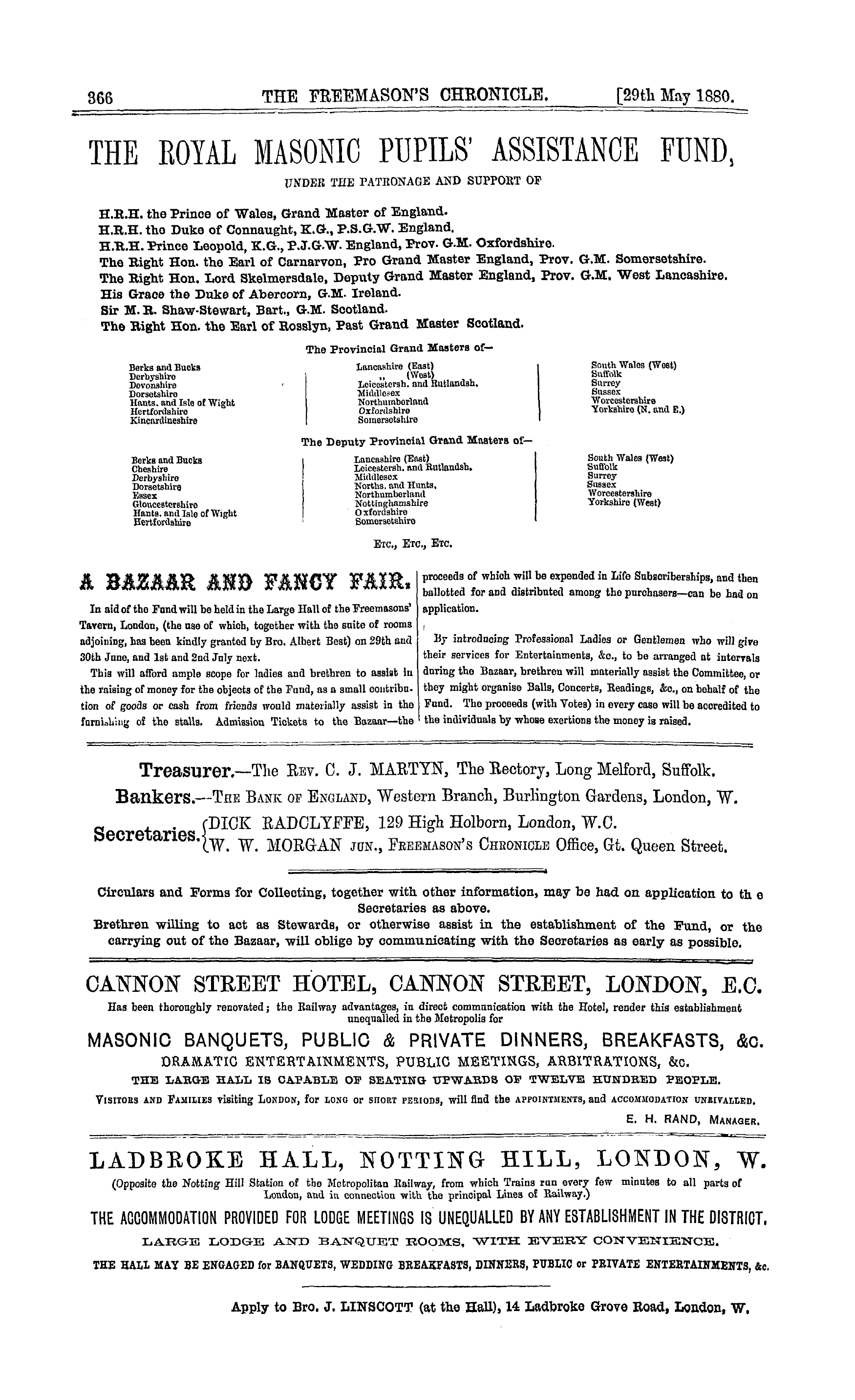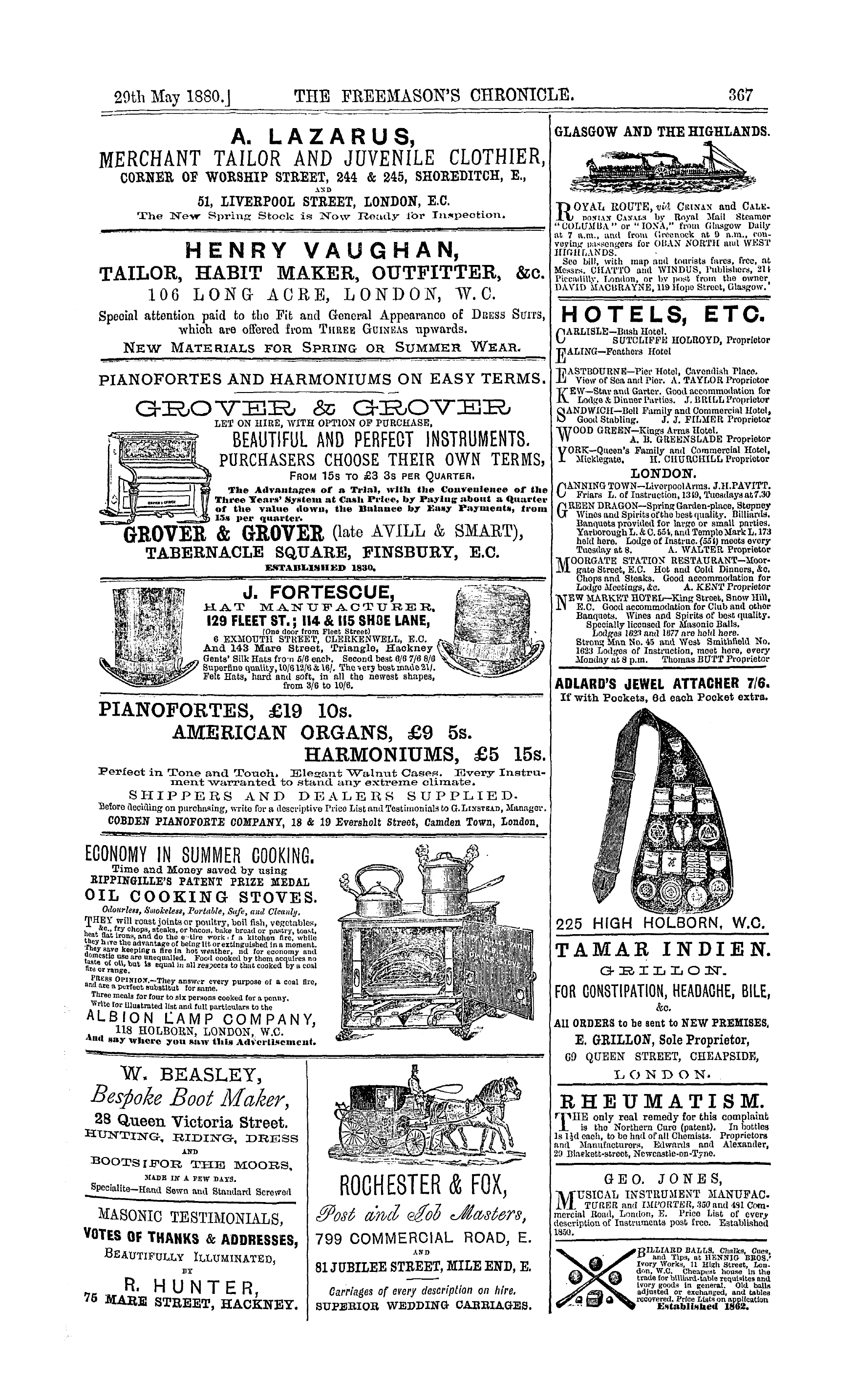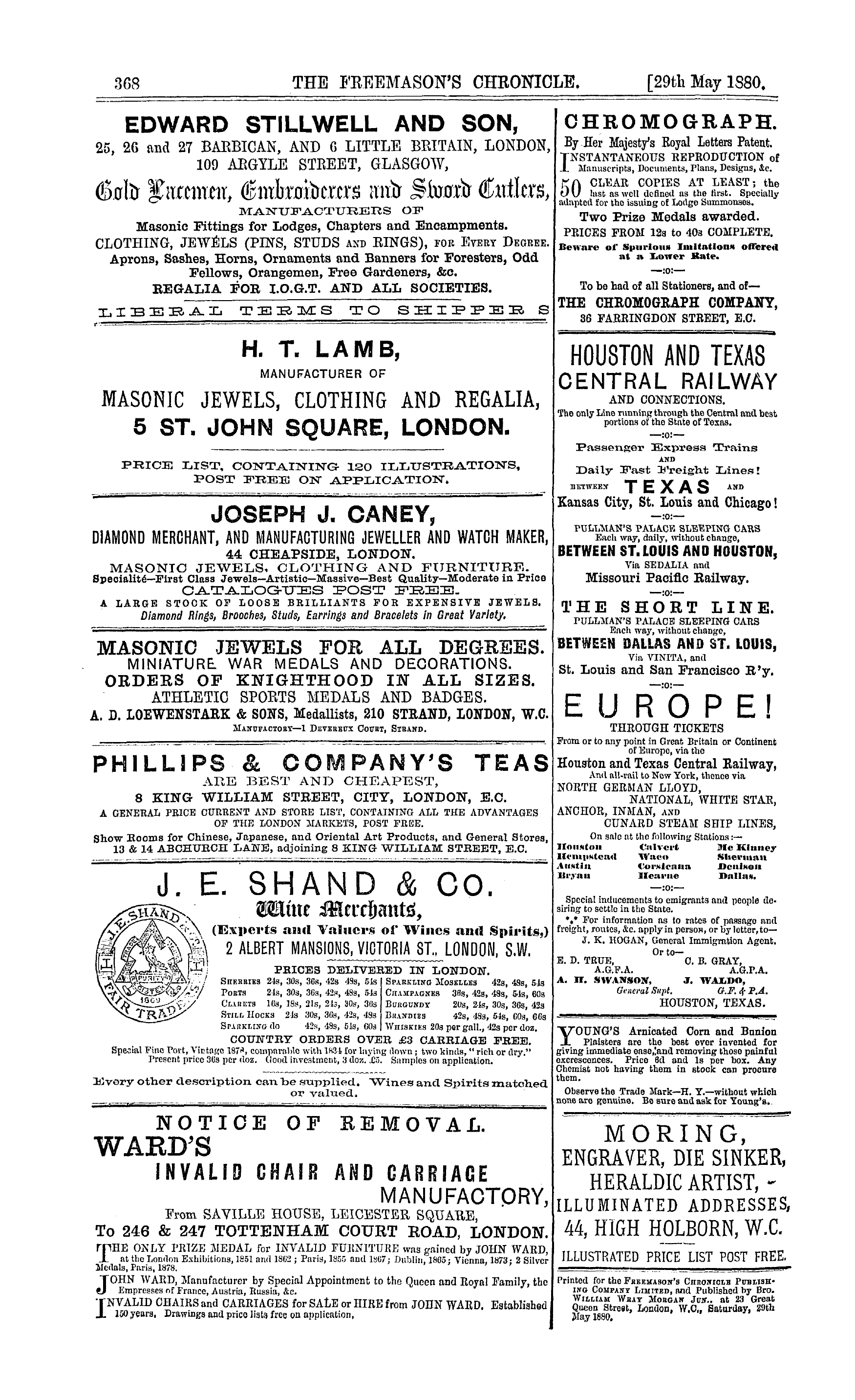-
Articles/Ads
Article UNITED GRAND LODGE. ← Page 2 of 2 Article TYPE AND SYMBOL-MONGERS. Page 1 of 2 Article TYPE AND SYMBOL-MONGERS. Page 1 of 2 →
Note: This text has been automatically extracted via Optical Character Recognition (OCR) software.
United Grand Lodge.
to read may not visit the library time after time , and find the book they wish to consult is already engaged . Reports of the Proceedings of Foreign Grand Lodges should by themselves form an important branch of tho Library , and there are many well-established foreign Masonic periodicals ,
to subscribe to which seems only an act of duty . Tims what with rare old books , tho costly publications of the day , binding , when necessary , or purchasing Reports of foreign Grand Lodges , and subscribing to and binding periodical Masonic publications , the purchasing powers of
£ 25 per annum will be very terribly taxed in order to show anything liko a satisfactory result . One rare book may cost a third , the half , or even a greater proportion of the whole sum , and the remainder would be equal to the provision of but a very modest supply of literature and
binding . "We are awaro that book-collecting by amateurs is a somewhat costly hobby , bnt even if the formation or extension of a library is entrusted to experienced hands , tho purse strings must not be top tightly drawn . £ 100 per annum would not be an extravagant sum ; but as to
£ 25—we presume the grave and reverend Board of General Purposes have for once in th ' cir way been guilty of perpetrating a joke . They know a library is desirable , but thoy are also well aware that not one Mason in a hundred ever troubles himself to read a Masonic book , and though they are
sensible the library as it is needs preservation and addition , they recommend the expenditure of a sum which will do as little as possible , and yet keep up something like a regard for appearances . £ 25 per annum for a Grand Lodge Library ! Well , ifc has at least this merit—that it is better than no vote at all .
There are two motions to be submitted , of ¦ which one by Lieut .-Col . Creaton , for tho usual vote of £ 70 to provide coals for the inmates of the Benevolent Asylum at Croydon , is always passed nem con . The other will be brought forward by Bro . Jas . Stevens , who is anxious that
effect should be given to the resolution of Grand Lodge as agreed to on 1 st December 1 SG 9 , and confirmed on 2 nd March 1870 . In other words , Bro . Stevens means to rc-open tho question on which he was so signally defeated some short time back . Now our opinions as to the
desirability of a uniformity of observance in ritual , so far as essentials are concerned , are too well known for us to waste any time in again referring to them . But though wo still abide as firmly as ever by our old views , we must remind Bro . Stevens that there is or ought to be among
Masons such a quality as discretion , and that ifc is most indiscreet in him , after having been beaten in March , to come forward again and challenge his successful opponents to another battle royal in Juno . We trust he will have tho good sense to drop his motion , and by so doing show
that he accepts his beating in a manly , English , and Masonic fashion . Moreover , no great harm will come if the resolution of Grand Lodge , passed in 186 ' 9 and confirmed in 1870 , which has lain dormant for ten years ,
remains for a year or two longer a dead letter . We have suffered nothing by having so long allowed it to be of none effect , and doubtless we shall survive the enormit y of allowing it to remain so a little longer .
Type And Symbol-Mongers.
TYPE AND SYMBOL-MONGERS .
BY BRO . JACOB NORTON .
" nriHAT fact [ alluding to Jonah ] expresses , prefigures , or typifies JL another fact of a higher and more important nature . " So reasoned Dr . Waterland , and so reason most commentators on sacred books . And if Jack the Giant Killer and Old Mother Hubbard had been incorporated by compilers of sacred books into their collection , pions commentators would not only swear to the literal truth of
those stories , bnt would also go into ectasies about "tho profundit y , sublimity , deep , and exalting thought which lie hidden in those sacred narratives , " and thousands would probably havo suffered martyrdom ere this for disbelieving either the truth of the stories , or the interpretations of said commentators . Old writings usually abound in obsolete or forgotten words and
phrases . Copiers may also have added to the conftision by alterations they made either through carelessness or wilfulness . These facts are generally admitted by critics of secular works , bnt not so by pious commentators of sacred books . These will never allow for the changes in modes of thought and expression which may have taken place , or
of a possibility of any mistakes or alterations by copiers of sacred books , and so they go to work , and ascribe meanings to passages which the anthors of the books never dreamt of , when a pet soulsaving dogma has to be proved . Then these commentators will swear that up means down , and dovm means up ; that # ast means future .
Type And Symbol-Mongers.
and fujiire means past ; that Gill means Jack , and Jack means Gill ; and with tho assistance of types , figures , and allegories , they manage to prove anything they please . Philo Jiukcns took it into his head that Plato stole his philosophy , uidruli'iir his notion of a Trinity , from tho writings of Moso 3 . aud to prove which Philo claimed that Scripture had two meanings , viz .,
literal and figurative And so , by fanciful types and allegories , ho transmogrified Moses into some sort of a Trinitarian . This method of reasoning was adopted to a limited extent by Jews , but to an unlimited extent by Christians . Thns , Justin Martyn , in his controversy with a Jew named Trypho , among other nonsenso , told him : — "Ho who is called the 'Angel of tho Counsel' and 'Man' by
Ezekiel ; and liko tho ' Son of Man ' by David ; and ' Christ' and 'Stono' by ma \ vy ; and 'Wisdom' by Solomon ; and 'Joseph' and . ludaha' and the ' Star ' by Moses ; and tho ' East' by Zechariah ; and the ' Suffering One' and ' Jacob' and ' Israel' by Isaiah ; and a ' Rod ' and a ' Flowor' and a ' Corner Stone' and tho ' Sou of God , ' & c . —all which meant Christ . " He also says the marriage of Jacob
was a type of Christ ; Rachel is a type of tho Church , and ! Noah is a figuro of Christ , " who regenerated us by water , faith , and wood . " Irenrous said that the boy who led Samson was a type of John tho Baptist , and because Christ " bore the burden of our sins , " therefore ho mado " Balaam ' s ass a type of Christ . " * But it is needless to multiply this kind of quotations , for tho headings of tho chapters
of the Old Testament , in Catholic and Protestant Bibles , abound in such absurdities . If , however , that kind of reasoning had been confined to churches , Sunday schools , and religious publications , it would not havo been my bnsiness to find fault . But when these topics are introduced into Lodges , and into Masonio publications as Masonic teachings ,
then it becomes my duty to expose , to protest against , and even to rebnke , their impertinent Jesuitism . Thus , according to the teaching of Christianising luminaries , the three degrees , the threo principal Lodgo Officers , and other threes in tho ritual signify the Trinity . The lion , lamb , pelican , fish , Aaron's rod , a candlestick , and a pot of incense typify Christ . In short , they teach that tho whole object
and aim of Masonry , from the days of Grand Master Adam to the present time , is nothing else bnt to indicate salvation through Christ . And it is needless to prove that our so-called Masonic publications abound in that kind of staff . And now I will call attention to the inverted letter T on the English Master ' s apron , about which no explanation is given in the
authorised ritual and lectures , or what are generally supposed to be authorised . If any one had asked mo what J . mean , I might have suggested that it is a rndo imitation of the Master ' s gavel . Bro . Rosseter , however , whose head is filled with the mysteries of Babylonian and Egyptian Masonry , calls this J _ a "Tau , " and says that Nimrod had his head decorated with " Tans . "
Tho emblem of the R . A . Mason is •_!_ ¦ , which the learned call " Triple Tau . " Whether Nimrod ' s head was adorned with single or triple Taus , Bro . Rosseter failed to enlighten us ( see FREEMASON ' S CHRONICLE , 9 th August 1879 ) . It is however my opinion that the tripling was invented in the last century for the R . A . degree manufactured for the Ancients ; and the upper part thereof was turned
upside down ( for what reason no one knows ) , and placed upon the Master ' s apron , probably not beforo 1813 , and this mark is unknown to Craft Masons , at least outside of Great Britain and her dependencies . But what is the meaning of Tau ? To ascertain this , I consulted the writings of the greatest expounder of Masonic conundrums , viz ., Dr . Mackey ( Lexicon and Cyclopaxlia ) , who says : —
" Tho Tan cross , or cross of St . Anthony , ( so called because it is said to havo been the cross on which that saint suffered martyrdom ) , is a cross in the form of a Greek "]" •... In the initiation in Hindostan the Tau cross , under the name of Tiluk , was marked upon tho body of the candidate as a sign that he was set apart for sacred mysteries . Tho same mark was familiar to the ancient Hebrews , for ,
in fcho vision of Ezekiel ib is thus alluded to , ' go through the midst of the city , and set a mark ( in the original , in Tau ) upon the foreheads of the men that sigh and that cry for all the abominations that be done jn the midst thereof . ' This mark was to distinguish them as persons to be saved on account of their sorrow for sin , from thoso who , as idolators , were to be slain ; and its form was that of a Hebrew
letter Tau , which in tho ancient Phoenician alphabet , aud on the coins of the Maccabees , has the shape of across . . . . Finally , observe that the Tau is the last letter of the Hebrew alphabet , as the aleph is the first , . . . and we see another consecration of this symbol in the expression 'I am the Alpha and the Omega , tho beginning and the end , ' which , spoken in the Hebrew language , would be , I am the Aleph and the Tau . ... Wo aro not therefore
surprised that tho Tau cross has beon adopted as one of the symbols of Masonry . " " According to the Talmndists" [ what Talmndists ?] "the symbol "J " was much older than the time of Ezekiel : for , say they , " [ where ?] " that when Moses anointed Aaron as high priest , he marked his forehead with this sign . " In his Cyclopaedia , after describing tho Triple Tau , Dr . Mackey
says : — " Tin ' s emblem , placed in the centre of a triangle and circle—both emblems of tho Deity" [ why ?] " constitutes the jewel of the Royal Arch as practised in England , where it is so highly esteemed as to bo
Note: This text has been automatically extracted via Optical Character Recognition (OCR) software.
United Grand Lodge.
to read may not visit the library time after time , and find the book they wish to consult is already engaged . Reports of the Proceedings of Foreign Grand Lodges should by themselves form an important branch of tho Library , and there are many well-established foreign Masonic periodicals ,
to subscribe to which seems only an act of duty . Tims what with rare old books , tho costly publications of the day , binding , when necessary , or purchasing Reports of foreign Grand Lodges , and subscribing to and binding periodical Masonic publications , the purchasing powers of
£ 25 per annum will be very terribly taxed in order to show anything liko a satisfactory result . One rare book may cost a third , the half , or even a greater proportion of the whole sum , and the remainder would be equal to the provision of but a very modest supply of literature and
binding . "We are awaro that book-collecting by amateurs is a somewhat costly hobby , bnt even if the formation or extension of a library is entrusted to experienced hands , tho purse strings must not be top tightly drawn . £ 100 per annum would not be an extravagant sum ; but as to
£ 25—we presume the grave and reverend Board of General Purposes have for once in th ' cir way been guilty of perpetrating a joke . They know a library is desirable , but thoy are also well aware that not one Mason in a hundred ever troubles himself to read a Masonic book , and though they are
sensible the library as it is needs preservation and addition , they recommend the expenditure of a sum which will do as little as possible , and yet keep up something like a regard for appearances . £ 25 per annum for a Grand Lodge Library ! Well , ifc has at least this merit—that it is better than no vote at all .
There are two motions to be submitted , of ¦ which one by Lieut .-Col . Creaton , for tho usual vote of £ 70 to provide coals for the inmates of the Benevolent Asylum at Croydon , is always passed nem con . The other will be brought forward by Bro . Jas . Stevens , who is anxious that
effect should be given to the resolution of Grand Lodge as agreed to on 1 st December 1 SG 9 , and confirmed on 2 nd March 1870 . In other words , Bro . Stevens means to rc-open tho question on which he was so signally defeated some short time back . Now our opinions as to the
desirability of a uniformity of observance in ritual , so far as essentials are concerned , are too well known for us to waste any time in again referring to them . But though wo still abide as firmly as ever by our old views , we must remind Bro . Stevens that there is or ought to be among
Masons such a quality as discretion , and that ifc is most indiscreet in him , after having been beaten in March , to come forward again and challenge his successful opponents to another battle royal in Juno . We trust he will have tho good sense to drop his motion , and by so doing show
that he accepts his beating in a manly , English , and Masonic fashion . Moreover , no great harm will come if the resolution of Grand Lodge , passed in 186 ' 9 and confirmed in 1870 , which has lain dormant for ten years ,
remains for a year or two longer a dead letter . We have suffered nothing by having so long allowed it to be of none effect , and doubtless we shall survive the enormit y of allowing it to remain so a little longer .
Type And Symbol-Mongers.
TYPE AND SYMBOL-MONGERS .
BY BRO . JACOB NORTON .
" nriHAT fact [ alluding to Jonah ] expresses , prefigures , or typifies JL another fact of a higher and more important nature . " So reasoned Dr . Waterland , and so reason most commentators on sacred books . And if Jack the Giant Killer and Old Mother Hubbard had been incorporated by compilers of sacred books into their collection , pions commentators would not only swear to the literal truth of
those stories , bnt would also go into ectasies about "tho profundit y , sublimity , deep , and exalting thought which lie hidden in those sacred narratives , " and thousands would probably havo suffered martyrdom ere this for disbelieving either the truth of the stories , or the interpretations of said commentators . Old writings usually abound in obsolete or forgotten words and
phrases . Copiers may also have added to the conftision by alterations they made either through carelessness or wilfulness . These facts are generally admitted by critics of secular works , bnt not so by pious commentators of sacred books . These will never allow for the changes in modes of thought and expression which may have taken place , or
of a possibility of any mistakes or alterations by copiers of sacred books , and so they go to work , and ascribe meanings to passages which the anthors of the books never dreamt of , when a pet soulsaving dogma has to be proved . Then these commentators will swear that up means down , and dovm means up ; that # ast means future .
Type And Symbol-Mongers.
and fujiire means past ; that Gill means Jack , and Jack means Gill ; and with tho assistance of types , figures , and allegories , they manage to prove anything they please . Philo Jiukcns took it into his head that Plato stole his philosophy , uidruli'iir his notion of a Trinity , from tho writings of Moso 3 . aud to prove which Philo claimed that Scripture had two meanings , viz .,
literal and figurative And so , by fanciful types and allegories , ho transmogrified Moses into some sort of a Trinitarian . This method of reasoning was adopted to a limited extent by Jews , but to an unlimited extent by Christians . Thns , Justin Martyn , in his controversy with a Jew named Trypho , among other nonsenso , told him : — "Ho who is called the 'Angel of tho Counsel' and 'Man' by
Ezekiel ; and liko tho ' Son of Man ' by David ; and ' Christ' and 'Stono' by ma \ vy ; and 'Wisdom' by Solomon ; and 'Joseph' and . ludaha' and the ' Star ' by Moses ; and tho ' East' by Zechariah ; and the ' Suffering One' and ' Jacob' and ' Israel' by Isaiah ; and a ' Rod ' and a ' Flowor' and a ' Corner Stone' and tho ' Sou of God , ' & c . —all which meant Christ . " He also says the marriage of Jacob
was a type of Christ ; Rachel is a type of tho Church , and ! Noah is a figuro of Christ , " who regenerated us by water , faith , and wood . " Irenrous said that the boy who led Samson was a type of John tho Baptist , and because Christ " bore the burden of our sins , " therefore ho mado " Balaam ' s ass a type of Christ . " * But it is needless to multiply this kind of quotations , for tho headings of tho chapters
of the Old Testament , in Catholic and Protestant Bibles , abound in such absurdities . If , however , that kind of reasoning had been confined to churches , Sunday schools , and religious publications , it would not havo been my bnsiness to find fault . But when these topics are introduced into Lodges , and into Masonio publications as Masonic teachings ,
then it becomes my duty to expose , to protest against , and even to rebnke , their impertinent Jesuitism . Thus , according to the teaching of Christianising luminaries , the three degrees , the threo principal Lodgo Officers , and other threes in tho ritual signify the Trinity . The lion , lamb , pelican , fish , Aaron's rod , a candlestick , and a pot of incense typify Christ . In short , they teach that tho whole object
and aim of Masonry , from the days of Grand Master Adam to the present time , is nothing else bnt to indicate salvation through Christ . And it is needless to prove that our so-called Masonic publications abound in that kind of staff . And now I will call attention to the inverted letter T on the English Master ' s apron , about which no explanation is given in the
authorised ritual and lectures , or what are generally supposed to be authorised . If any one had asked mo what J . mean , I might have suggested that it is a rndo imitation of the Master ' s gavel . Bro . Rosseter , however , whose head is filled with the mysteries of Babylonian and Egyptian Masonry , calls this J _ a "Tau , " and says that Nimrod had his head decorated with " Tans . "
Tho emblem of the R . A . Mason is •_!_ ¦ , which the learned call " Triple Tau . " Whether Nimrod ' s head was adorned with single or triple Taus , Bro . Rosseter failed to enlighten us ( see FREEMASON ' S CHRONICLE , 9 th August 1879 ) . It is however my opinion that the tripling was invented in the last century for the R . A . degree manufactured for the Ancients ; and the upper part thereof was turned
upside down ( for what reason no one knows ) , and placed upon the Master ' s apron , probably not beforo 1813 , and this mark is unknown to Craft Masons , at least outside of Great Britain and her dependencies . But what is the meaning of Tau ? To ascertain this , I consulted the writings of the greatest expounder of Masonic conundrums , viz ., Dr . Mackey ( Lexicon and Cyclopaxlia ) , who says : —
" Tho Tan cross , or cross of St . Anthony , ( so called because it is said to havo been the cross on which that saint suffered martyrdom ) , is a cross in the form of a Greek "]" •... In the initiation in Hindostan the Tau cross , under the name of Tiluk , was marked upon tho body of the candidate as a sign that he was set apart for sacred mysteries . Tho same mark was familiar to the ancient Hebrews , for ,
in fcho vision of Ezekiel ib is thus alluded to , ' go through the midst of the city , and set a mark ( in the original , in Tau ) upon the foreheads of the men that sigh and that cry for all the abominations that be done jn the midst thereof . ' This mark was to distinguish them as persons to be saved on account of their sorrow for sin , from thoso who , as idolators , were to be slain ; and its form was that of a Hebrew
letter Tau , which in tho ancient Phoenician alphabet , aud on the coins of the Maccabees , has the shape of across . . . . Finally , observe that the Tau is the last letter of the Hebrew alphabet , as the aleph is the first , . . . and we see another consecration of this symbol in the expression 'I am the Alpha and the Omega , tho beginning and the end , ' which , spoken in the Hebrew language , would be , I am the Aleph and the Tau . ... Wo aro not therefore
surprised that tho Tau cross has beon adopted as one of the symbols of Masonry . " " According to the Talmndists" [ what Talmndists ?] "the symbol "J " was much older than the time of Ezekiel : for , say they , " [ where ?] " that when Moses anointed Aaron as high priest , he marked his forehead with this sign . " In his Cyclopaedia , after describing tho Triple Tau , Dr . Mackey
says : — " Tin ' s emblem , placed in the centre of a triangle and circle—both emblems of tho Deity" [ why ?] " constitutes the jewel of the Royal Arch as practised in England , where it is so highly esteemed as to bo






